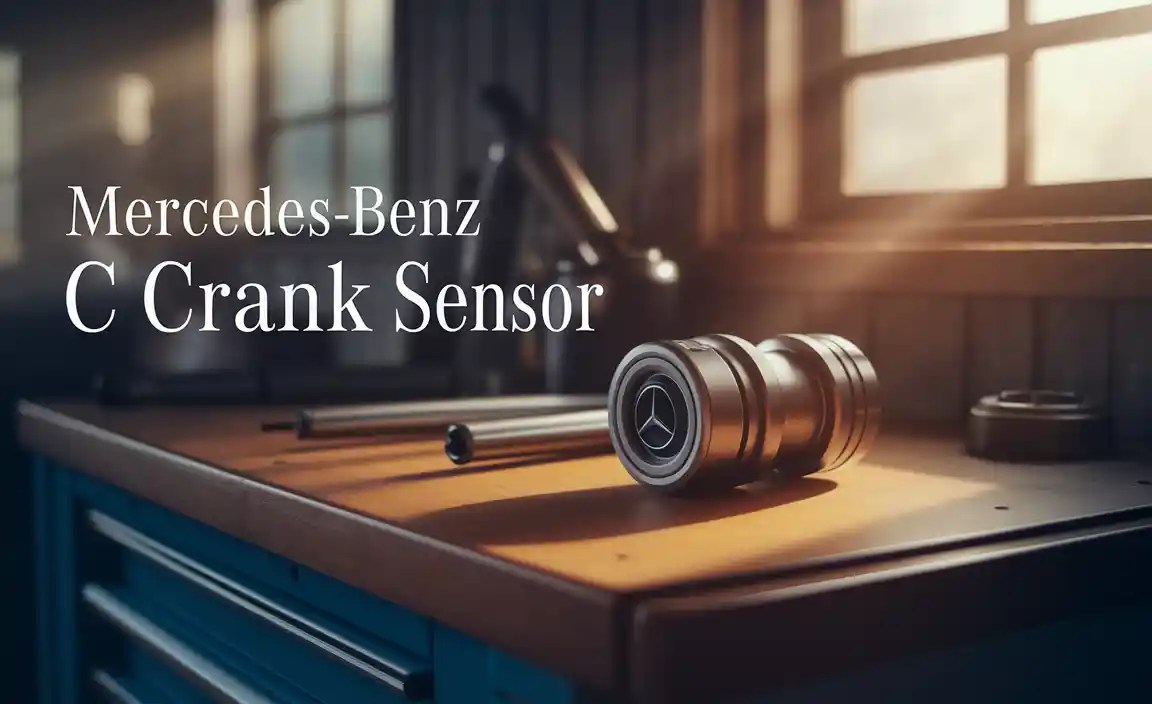Mercedes-Benz C Class Crank Sensor: Ultimate Performance
The C Class crank sensor is vital for your Mercedes’ engine timing and performance. A failing sensor can cause rough idling, stalling, and poor acceleration. Replacing it ensures smooth operation and unlocks your C Class’s true potential.
Owning a Mercedes-Benz C Class is a statement of refined taste and engineering excellence. When your esteemed vehicle doesn’t perform as expected, it can be frustrating. One Component that plays a surprisingly significant role in your engine’s health and the ultimate performance you experience is the crankshaft position sensor, often referred to as the C Class crank sensor. If you’ve noticed rough idling, hesitation, or even stalling, this small-but-mighty part might be the culprit.
Don’t worry, understanding and addressing issues with your C Class crank sensor doesn’t require a degree in automotive engineering. We’re here to guide you through what it is, why it’s important for your car’s performance, how to identify potential problems, and what the solutions entail. Get ready to bring your C Class back to its peak operating condition.

What is the Crankshaft Position Sensor (Crank Sensor)?
Your Mercedes-Benz C Class is a marvel of modern automotive technology, and at the heart of its sophisticated engine management system lies the crankshaft position sensor (CKP). This unassuming sensor is fundamental to how your engine runs smoothly and efficiently. Its primary job is to monitor the rotational speed and exact position of the crankshaft. Think of it as the engine’s pulse reader, constantly relaying critical information to the Engine Control Unit (ECU), also known as the powertrain control module (PCM).
The ECU uses the data from the crank sensor to precisely determine when to inject fuel into the cylinders and when to fire the spark plugs. This timing is absolutely crucial. If the ECU receives inaccurate or no data from the crank sensor, it cannot manage these events correctly, leading to a host of drivability issues that directly impact your driving experience and the performance of your C Class.
In essence, the C Class crank sensor acts as the conductor of your engine’s orchestra, ensuring every component works in perfect harmony. Without its accurate signals, the engine wouldn’t know where it is in its cycle, making smooth operation impossible.
Why the Crank Sensor is Crucial for C Class Performance
The importance of the crankshaft position sensor to your C Class’s ultimate performance cannot be overstated. This sensor is not just a diagnostic tool; it’s an active participant in the engine’s daily operation. Its precise timing is what allows your Mercedes to deliver that renowned smooth power delivery, responsive acceleration, and optimal fuel efficiency.

- Precise Ignition Timing: The ECU relies on the crank sensor’s signal to know the exact position of the crankshaft. This allows it to trigger the spark plug at the precise moment needed to ignite the air-fuel mixture efficiently. Incorrect timing leads to misfires, reduced power, and increased emissions.
- Accurate Fuel Injection: Similarly, the fuel injectors must deliver fuel at the perfect moment relative to the piston’s position. The crank sensor helps the ECU orchestrate this, ensuring optimal combustion for power and economy.
- Engine Speed Monitoring: The sensor tells the ECU how fast the engine is spinning. This information is vital for various engine functions, including idle speed control, gear shifting in automatic transmissions, and preventing over-revving.
- Starting the Engine: A functioning crank sensor is absolutely essential for your engine to start. Without its signal, the ECU cannot initiate the fuel injection and ignition sequences required to bring the engine to life.
When the C Class crank sensor is performing optimally, your vehicle will exhibit smooth idling, strong acceleration, and efficient operation. Any degradation in its performance directly translates to a compromise in these areas. For enthusiasts who value the exhilarating performance of their Mercedes-Benz, a healthy crank sensor is non-negotiable.
Common Signs of a Failing C Class Crank Sensor
Recognizing the symptômes of a failing C Class crank sensor is key to addressing the problem before it escalates. These signs often manifest as a decline in engine performance and can be quite noticeable. Early detection allows for a more straightforward fix and prevents potential damage to other engine components.
Here are the most common indicators that your crankshaft position sensor might be on its way out:
- Rough Idling or Stalling: This is often one of the first and most obvious signs. If your C Class’s engine runs rough when idling, shakes excessively, or cuts out unexpectedly, a faulty crank sensor is a prime suspect. The ECU is struggling to maintain a stable combustion cycle.
- Difficulty Starting or No Start: If your engine cranks over but refuses to start, or if it starts but immediately dies, the crank sensor is often the reason. It’s crucial for initiating the starting sequence.
- Hesitation or Poor Acceleration: When you press the accelerator, and your car stutters, hesitates, or simply doesn’t have the usual zip, it can point to an intermittent or failing crank sensor. The ECU isn’t getting consistent positional data, leading to misfires under load.
- Engine Misfires: You might feel jerky movements or hear popping sounds from the exhaust as the engine struggles to fire on all cylinders. This is a direct result of the ECU not knowing precisely when to fire the spark plugs due to faulty sensor input.
- Check Engine Light (CEL) Illuminates: In many cases, a failing crank sensor will trigger your Check Engine Light. The OBD-II system detects a discrepancy or absence of the expected signal and flags it. The fault code associated with a crank sensor issue is often P0335 or similar.
- Increased Fuel Consumption: While not always the primary symptom, an engine struggling with incorrect timing due to a crank sensor fault will inevitably become less fuel-efficient as combustion is no longer optimized.
It’s important to note that some of these symptoms can overlap with other engine issues. However, when multiple symptoms appear together, especially those related to starting and idling, the C Class crank sensor becomes a very strong candidate for the cause.
Diagnosing a Faulty C Class Crank Sensor
Proper diagnosis is crucial before deciding on a repair. While the symptoms can be clear, pinpointing the exact cause requires a systematic approach. Fortunately, diagnosing a C Class crank sensor issue is usually manageable with the right tools and knowledge.

Tools You Might Need:
- OBD-II Scanner: This is your first and most important tool. It connects to your car’s diagnostic port and retrieves fault codes stored by the ECU. Codes related to the crankshaft position sensor often start with “P0335.”
- Multimeter: Used to test the electrical resistance and voltage output of the sensor itself.
- Basic Hand Tools: Wrenches, sockets, and screwdrivers to access and remove the sensor.
- Inspection Mirror and Light: To help locate the sensor’s position.
- Wiring Diagram: Essential for tracing the sensor’s wiring harness and testing connections. You can usually find these in your Mercedes-Benz service manual or an online database like ALLDATA or Mitchell 1.
Diagnostic Steps:
- Retrieve Diagnostic Trouble Codes (DTCs): Connect your OBD-II scanner to the diagnostic port (usually located under the dashboard on the driver’s side). Scan for codes and note any related to the crankshaft position sensor (e.g., P0335, P0336, P0337, P0338, P0339). Even if no codes are present, the symptoms might still indicate a failing sensor.
- Inspect the Sensor and Wiring: Locate the crankshaft position sensor. It’s typically mounted on the engine block, near the crankshaft pulley or flywheel. Visually inspect the sensor for any signs of damage, cracks, or corrosion. Also, carefully examine the wiring harness connected to the sensor for any frayed wires, loose connectors, or signs of damage from heat or physical interference.
- Test the Sensor’s Electrical Properties: Consult your Mercedes-Benz service manual for the specific resistance and voltage specifications for your C Class model. Using a multimeter, test the sensor’s resistance according to the manual’s procedure. You may also need to test for voltage output while the engine is cranking (if the car starts).
- Check for Signal Interruption: Sometimes, a sensor may work intermittently. You can monitor the crank sensor signal using a more advanced diagnostic scanner or an oscilloscope while the engine is cranking or running. A stable, consistent signal is expected. Gaps or dropouts in the signal indicate a problem.
- Examine the Reluctor Wheel (If Accessible): The crank sensor often reads a toothed wheel (reluctor wheel) attached to the crankshaft. If this wheel is damaged, obstructed by debris, or has missing teeth, it will lead to incorrect readings, even if the sensor itself is fine. Access to the reluctor wheel can be difficult and may require removing other components.
If your OBD-II scanner indicates a specific fault code for the crank sensor, and the wiring appears intact, the sensor itself is the most likely culprit. However, a thorough inspection and testing process will confirm this.
C Class Crank Sensor Replacement: A How-To Guide
Replacing a C Class crank sensor is a task that many DIY enthusiasts can tackle with patience and the right approach. While the exact location can vary slightly between C Class models and engine types (e.g., W204, W205 with M271, M274, M276 engines), the general process is similar. Safety and careful handling of connections are paramount.

Tools and Materials:
- New Crankshaft Position Sensor (ensure it’s the correct part number for your specific C Class model and year)
- Socket set with extensions
- Wrench set
- Torque wrench
- Pliers
- Wire brush (for cleaning)
- Dielectric grease
- Safety glasses
- Gloves
- Jack and jack stands (if needed for access)
- Service manual for your C Class model
Step-by-Step Replacement Process:
- Safety First: Ensure the engine is completely cool. Disconnect the negative battery terminal to prevent electrical shorts. If you need to lift the vehicle for access, use jack stands properly on a level surface.
- Locate the Sensor: Consult your service manual to pinpoint the crank sensor’s exact location. It’s commonly found on the rear of the engine block, near the transmission bell housing, or sometimes on the side of the block closer to the crankshaft pulley. It will have an electrical connector attached to it.
- Access the Sensor: You may need to remove surrounding components to gain clear access. This could include air intake ducting, splash shields, or even parts of the exhaust system, depending on the engine layout.
- Disconnect the Electrical Connector: Carefully unplug the electrical connector from the old sensor. These connectors often have a locking tab that needs to be pressed or lifted to release. Avoid pulling on the wires themselves.
- Remove the Old Sensor: The crank sensor is typically held in place by one or two bolts. Use the appropriate socket and extension to remove these bolts. Once the bolts are out, gently twist and pull the sensor out of its mounting hole. It might be a bit snug due to the seal.
- Prepare the New Sensor: Clean the mounting bore on the engine block with a wire brush to remove any dirt, debris, or old gasket material. Ensure the new sensor is free of contaminants. Apply a small amount of dielectric grease to the connector of the new sensor. This helps ensure a good electrical connection and protects against moisture.
- Install the New Sensor: Insert the new crankshaft position sensor into its bore. Make sure it’s seated properly.
- Secure the New Sensor: Reinstall the mounting bolts. Tighten them to the torque specification found in your service manual. Overtightening can damage the sensor or the engine block, while undertightening can lead to leaks or the sensor coming loose.
- Reconnect the Electrical Connector: Plug the electrical connector firmly into the new sensor until it clicks into place, ensuring the locking tab engages.
- Reassemble Removed Components: Reinstall any parts you removed for access, ensuring all connections and fasteners are secure.
- Reconnect the Battery: Reconnect the negative battery terminal.
- Start and Test: Start the engine. It should now start and run smoothly without the previous symptoms. Clear any stored DTCs using your OBD-II scanner. Take your C Class for a test drive to ensure normal performance.
Remember to refer to your specific Mercedes-Benz C Class model’s service manual for precise torque specifications and any model-specific nuances. If you are uncomfortable with any part of this process, it’s always best to consult a professional.
When to Call a Professional Mechanic
While many Mercedes-Benz C Class owners enjoy the satisfaction of performing DIY repairs, there are certainly times when calling a professional mechanic is the wiser choice. The complexity of modern vehicles, especially luxury cars like a C Class, means that some tasks require specialized tools, diagnostic equipment, or expertise that goes beyond basic DIY capabilities.
Here are a few scenarios where consulting a Mercedes-Benz specialist is recommended:
- Lack of Proper Tools or Equipment: If you don’t have the necessary diagnostic scanner, torque wrench, or specific socket sizes required for the job, attempting the replacement could lead to mistakes or damage.
- Inability to Access the Sensor: For some C Class models, the crank sensor may be located in a very difficult-to-reach area, possibly behind major engine components or the transmission. Forcing access can be risky.
- Uncertainty in Diagnosis: If your OBD-II scanner provides multiple fault codes or if the symptoms are ambiguous and could point to several different issues, a professional has the advanced diagnostic tools and experience to accurately pinpoint the problem.
- Concerns About Warranty: If your C Class is still under warranty, performing certain repairs yourself could void the warranty. It’s always wise to check your warranty terms before undertaking any DIY work.
- Complex Electrical Issues: Crank sensor issues can sometimes stem from deeper electrical problems within the wiring harness or the ECU itself. Diagnosing and repairing these intricate electrical faults requires specialized knowledge.
- Discomfort or Lack of Confidence: If you feel uncomfortable or lack confidence at any stage of the diagnostic or repair process, it’s better to entrust the job to a qualified technician. This ensures the repair is done correctly and safely, preserving the performance and integrity of your Mercedes.
For optimal performance and peace of mind, especially with a sophisticated vehicle like a. C Class, leveraging the expertise of a certified Mercedes-Benz technician can be invaluable. They have access to the latest diagnostic software, genuine OEM parts, and the specific training to handle these complex systems.
Cost of C Class Crank Sensor Replacement
The cost of replacing a C Class crank sensor can vary depending on several factors. Understanding these variables can help you budget for the repair.

Factors Influencing Cost:
- Part Quality and Brand: OEM (Original Equipment Manufacturer) sensors from Mercedes-Benz will typically be more expensive than aftermarket alternatives. However, OEM parts are guaranteed to meet the exact specifications for your vehicle. High-quality aftermarket brands can offer a good balance of price and reliability.
- Labor Rates: The cost of labor varies significantly based on your geographic location and the hourly rates charged by the repair shop. Dealerships generally have higher labor rates than independent European car specialists or general mechanics.
- Accessibility of the Sensor: As mentioned earlier, if the crank sensor is in a difficult-to-access location requiring significant disassembly of other engine components, the labor time will increase, thereby raising the overall cost.
- Additional Repairs: Sometimes, during diagnosis, other related issues might be found. For example, if the wiring harness is significantly damaged, those repairs will add to the total cost.
Estimated Cost Breakdown:
Generally, you can expect the following cost ranges:
| Component | Estimated Cost (USD) |
|---|---|
| Crankshaft Position Sensor (Part Only) | $30 – $150 (Aftermarket) $80 – $250+ (OEM) |
| Labor (1-3 hours) | $100 – $400+ (depending on shop rates) |
| Total Estimated Cost | $130 – $650+ |
For a DIY replacement, you’ll primarily be responsible for the cost of the sensor itself and any tools you might need to acquire. Online automotive parts retailers often have competitive pricing on C Class crank sensors.
Maintaining Your C Class for Peak Performance
Keeping your Mercedes-Benz C Class in top condition involves more than just scheduled maintenance. Proactive care and attention to how your car performs can help prevent issues like a failing crank sensor from impacting your driving experience.






